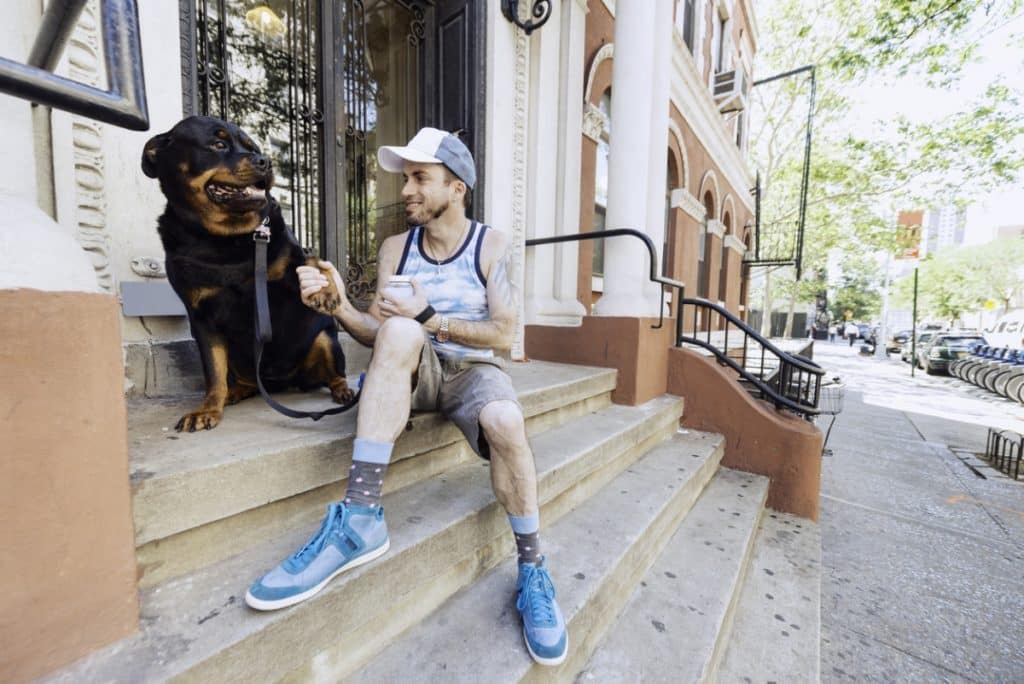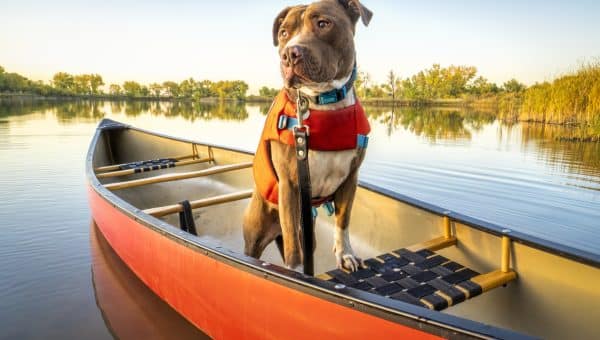- Not a substitute for professional veterinary help.
As with humans, a big move or a permanent change to a dog’s living environment is a major deal. If you have recently moved to the city from a more rural or suburban location and your dog has been used to calmer, quieter surroundings, they could be stressed or overwhelmed by their new city life.
Fortunately, dogs are incredibly resilient. With time and patience, they can learn to live happily in their new, much louder and busier home.
The key to helping your dog adjust is in building routines and positive associations, providing plenty of support and encouragement, and ensuring your dog’s innate needs are met—especially the ones they may be missing, like being in nature!
Here are some tips to help you both cope with this big change together.

iStock/Boogich
Give Your Dog Time to Adjust
Patience and compassion are paramount when it comes to any major change in your dog’s life. Don’t expect your pup to seamlessly adapt to their new surroundings. It will take time and practice. The most important thing is that your dog trusts you to be their safe, secure place in the world during this time of upheaval.
Build Routines in Your New Home
Routines are powerful because they provide your dog with predictability—and predictability in a time of change is crucial in helping your dog navigate the new world they’ve found themselves in.
Building routines is simple—make patterns throughout your dog’s day so that they can anticipate what happens next.
Training tip: Prepare meals in the same way each time and deliver them in the same way. This may look like combining some ingredients together, heating them up, spreading them on a lick mat or scooping a cup of kibble into a snuffle mat, then setting it down in the same location every day.
Keep the same order of operations for each routine, and use the same wording or phrase (e.g. “Are you hungry? Let me get it ready,” “Ok, here ya go!”).
Create rituals around everything you do with your dog. This lays the foundation of stability and consistency and enables your dog to make sense of their environment instead of feeling the anxiety that comes with unpredictability.
View this post on Instagram
Make Positive Associations With Your Dog’s New Environment
Like humans, dogs learn by association. If your dog loves to go on walks, they most likely get excited when they see you grab the leash because the leash predicts the walk. Your dog has made a positive association to the leash because it predicts something they love.
We can create these positive associations on purpose for our dogs so that environmental stimuli predict something they love, which leads to more confidence and less fear of the unknown.
Training tip: Grab a treat pouch if you don’t already have one, and start this process immediately on arrival to the city. When your dog notices new sights and sounds, name what it is— “oh, that’s a garbage truck”—and throw some small high value (meat or cheese) pieces of food on the ground for your dog to sniff out. It’s imperative that the new, possibly scary thing comes first, your dog notices, then the delicious food gets dropped. Make sure your food is hidden in your pouch and not in your hand until after your dog notices the stimuli.
If your pup is unable to take food and/or gets frozen on the scary thing, you may need more distance from it. Get into your dog’s field of view, get playful, and run away or get behind a visual barrier. Then scatter some food!
If your pup is fleeing, barking, lunging or visibly distressed, consult a force free professional for one-on-one help acclimating your dog to their new city.
Provide Your Dog Plenty of Enrichment
Enrichment is any activity your dog finds innately satisfying—running, playing, chasing, sniffing, chewing, licking, shredding, foraging—and others depending on your dog’s genetics and unique preferences.
It is ideal to provide your dog outlets to meet these needs on a regular basis in best of times for overall behavioral health, and imperative to meet them during a time of change and uncertainty.
A dog who is coming from an environment where they’re used to spending their day roaming large areas of land and engaging in nature must be provided enrichment that continues to meet that need during and after the move. Luckily, we have rentable dog parks such as Sniffspot and decompression walks for that very thing.
Low-arousal enrichment like sniffing, chewing, or shredding are fantastic for regulating your dog’s nervous system and building confidence in times of higher stress. Add activities like these with a puzzle toy, a snuffle mat, or offer your dog some old cardboard or paper to chew or shred. Add these to your new daily routines and see your dog ease into their new city life feeling content and confident.
View this post on Instagram
Hacks for Walking Any Dog in the City
From puppies being introduced to the world, to teens who are an explosion of energy and curiosity, to older dogs who’d like some peace, these tips will help you navigate city streets with your pup while keeping them safe and distanced from stimuli they may find scary.
Prepare before you step outside for your walk. Pack your treat pouch with small pieces of high value food like meat or cheese—something your dog can continuously lick or eat—and grab a long-feed if you have one.
Avoid leash greetings with other dogs. Leash greetings are not an ideal way for dogs to meet each other. The leash takes away their crucial species-appropriate way to communicate with one another and can create tension and an inability to escape if uncomfortable. Keep an eagle eye out for other people and dogs. If someone is barreling toward you—cross the street, turn around and go in the opposite direction or step away from the street and scatter some treats on the ground while they pass.
Distance is your friend! Distance is your number one tool if your dog is unsure of something or someone on the walk. If your dog is getting stuck (freezing, staring) on a distraction they’re unsure about, get excited and get your dog’s attention by getting into their field of view, then playfully running in the opposite direction to get distance. Use the environment! Get behind a visual barrier like a car, a bush, or even a trash can. Use the space! There’s no rule that says you have to stay on the sidewalks at all times. Step off the sidewalk and into an alley, driveway, or parking lot if you need to. Give your dog space to explore and process. Positively associate your dog to seeing other dogs out and about but staying near you (same protocol as above).
View this post on Instagram
Use a long-feed or “treat magnet.” This will entice your dog to move with you when they’re unable to focus on you because their brain has gone offline (the thing in the environment is just too interesting to look away from). Stick the squeeze tube directly in front of their nose/mouth and as they eat, keep it there as you walk away and create distance from the distraction. This also reinforces your dog for walking by your side!
Get creative! Use neighborhood walks as time to bond with your dog. Long gone are the days of boring tight-leashed heeled walks. Instead, ask your dog to hop up on ledges or rocks in the environment (if they enjoy it)—urban agility! Or let your dog sniff a spot for five minutes if they want to—stop with them—take a deep breath and be present.
Be There for Your Dog
Just because your dog must transition from country to city living, doesn’t mean they can’t get their fill of their favorite things!
Remember, it’s OK to comfort and support your dog through this transitional period—in fact, they need it. Slow acclimation at your dog’s pace is important, as is having fun together! Don’t forget that part.
Moving is stressful any way you slice it, but if you’re mindful about it, you and your dog can help each other through it and maybe even grow your bond at the same time.





